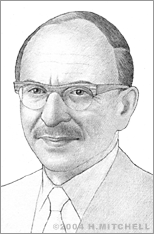Dennis Gabor
Dennis Gabor was born in Budapest, Hungary on June 5, 1900. As a youngster, he was interested in the inner workings of the things around him. At age ten, he designed a type of airplane-like carousel, and his parents helped him attain a patent for it. By the time he was a teenager, he had a small laboratory in his house where he worked on his own experiments in photography, radiation, and wireless x-rays and developed a passion for physics.
He attended the Technische Hochschule in Berlin where he received a bachelor’s degree in 1924 and a doctoral degree in 1927 in electrical engineering. There, he also had access to the University of Berlin. He visited often to learn more about physics in the presence of greats like Albert Einstein and Max Planck. During the course of his doctoral work, he developed a high-speed cathode ray oscillograph, which was detailed in his thesis "Recording of Transients in Electric Circuits with the Cathode Ray Oscillograph." He also created the first iron-protected magnetic electron lens.
In 1927, Gabor accepted a position with Siemens & Halske AG. There he was responsible for a number of discoveries, including a high-pressure quartz mercury lamp with a molybdenum (a heat-resistant metal) tape seal, which was subsequently used in street lamps. The seal is still used in street lamps to this day.
In 1933, as Adolf Hitler was coming to power in Germany, Gabor left the country, returning briefly to Hungary before settling in England. He was employed by the Thomson-Houston Co. in Rugby, where he worked on gas-discharge tubes. Soon, he began working with the BTH Research Laboratory. He stayed there until 1948, and it was at BTH that he began the most important work of his career, founding the field of holography.
A hologram is formed when the interference patterns of two waves of light are recorded on a piece of film. Today, holograms have a variety of uses, including being used to take measurements in particle physics; for security in credit cards and currency notes; in bar-code readers; to take impressions of valuable artifacts; and simply to capture three-dimensional images of animals, plants, or objects. At the time of Gabor’s research, holography was called "wavefront reconstruction." He developed the early principles of holographic theory while working on improvements to the resolution of the electron microscope. Progress in the field was made very slowly until more efficient light sources became available, namely, the laser.
In 1949, Gabor joined the Imperial College of Science and Technology in London, first as a reader in electronics, and later as a professor of applied electron physics. Between 1950 and 1953, he worked in collaboration with the AEI Research Laboratory on holography. Results were relatively unsatisfactory until the advent of the laser in 1960. The laser was a truly coherent light source – monochromatic and with a single light source. Its invention made it possible to create clear holographic images unlike any seen in earlier experiments. For his achievements in holography, Gabor was awarded the Nobel Prize for Physics in 1971.
Meanwhile, Gabor carried out many difficult investigations with his post-graduate assistants, including tackling a problem known as the Langmuir Paradox, an intense electron interaction that occurs in low-pressure plasma. Other developments included a holographic microscope, a new type of thermionic converter, an electron-velocity spectroscope, and a flat color television tube. Gabor’s body of significant theoretical work included communication theory (now known as structural theory), plasma theory, and magnetron theory.
Beginning in 1958, Gabor began spending much of his time on philosophical pursuits, especially defining, in his view, the future of the industrial civilization. He wrote three books: “Inventing the Future” (1963), “Innovations” (1970), and “The Mature Society” (1972). Among his famous sayings is, “The future does not need to be foretold but invented.”
His numerous awards and honors include the IEEE Medal of Honor (1970), Fellowship in the Royal Society (1956), the Thomas Young Medal of Physical Society (awarded in London in 1967), and the Albert Michelson Medal of The Franklin Institute (awarded in Philadelphia in 1968). He was also named a Commander of the Order of the British Empire in 1970.
Gabor retired in 1967, but he and his wife continued for years to travel between England, where he was a Senior Research Fellow at the Imperial College; the U.S., where he was Staff Scientist of CBS Laboratories in Stamford, Conn.; and Italy, where he had a private villa. He died in London in 1979.


